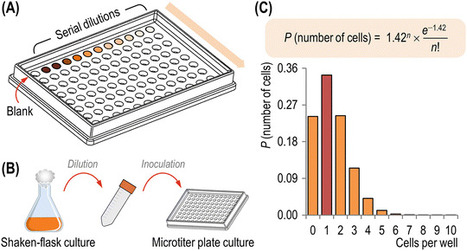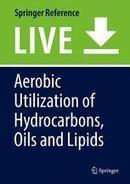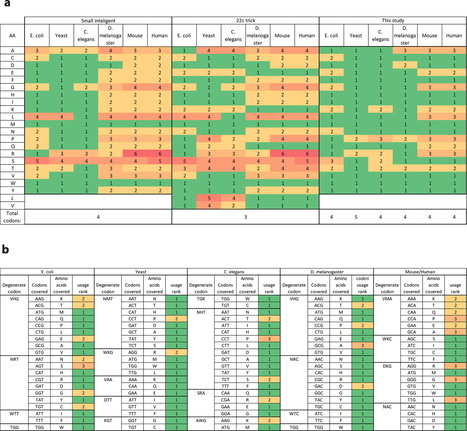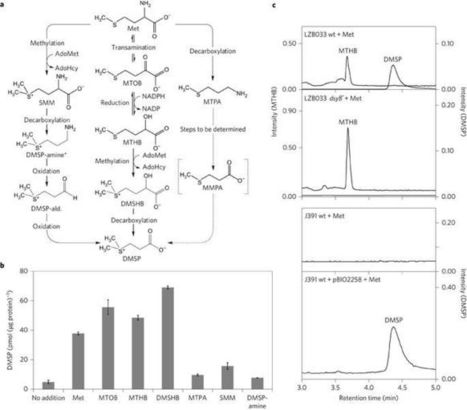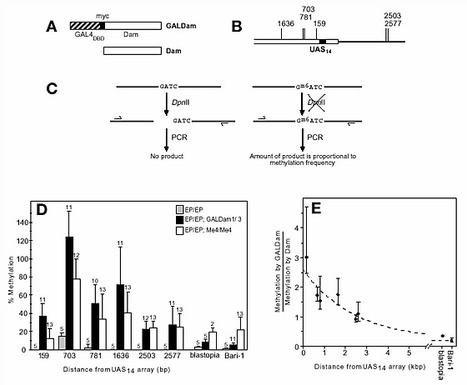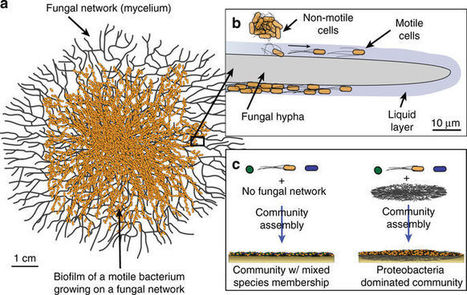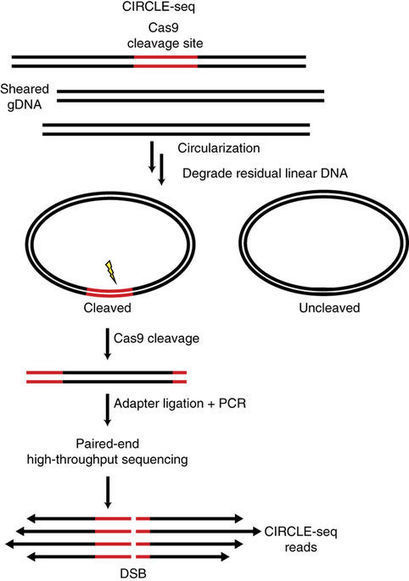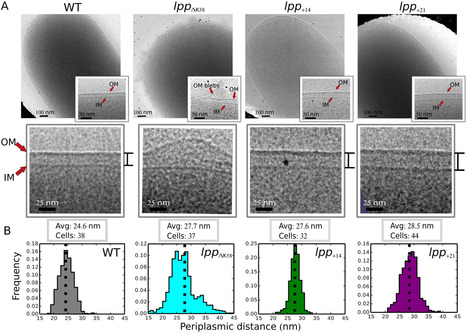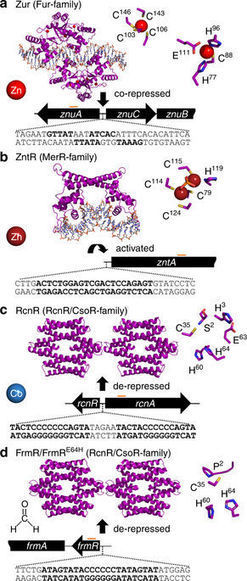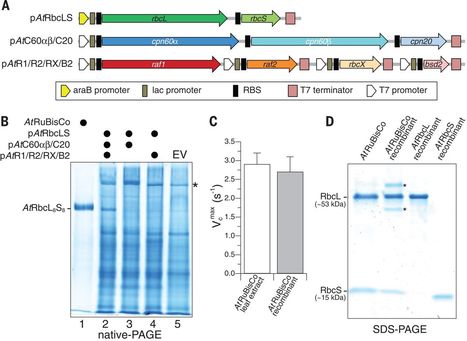 Your new post is loading...

|
Scooped by
?
March 1, 2018 8:35 AM
|
The soil bacterium Pseudomonas putida is rapidly becoming a platform of choice for applications that require a microbial host highly resistant to different types of stresses and elevated rates of reducing power regeneration. P. putida is capable of growing in a wide variety of carbon sources that range from simple sugars to complex substrates such as aromatic compounds. Interestingly, the growth of the reference strain KT2440 on glycerol as the sole carbon source is characterized by a prolonged lag phase, not observed with other carbon substrates. This macroscopic phenomenon has been shown to be connected with the stochastic expression of the glp genes, which encode the enzymes needed for glycerol processing. In this protocol, we propose a general procedure to examine bacterial growth in small-scale cultures while monitoring the metabolic activity of individual cells. Assessing the metabolic capacity of single bacteria by means of fluorescence microscopy and flow cytometry, in combination with the analysis of the temporal takeoff of growth in single-cell cultures, is a simple and easy-to-implement approach. It can help to understand the link between macroscopic phenotypes (e.g., microbial growth in batch cultures) and stochastic phenomena at the genetic level. The implementation of these methodologies revealed that the adoption of a glycerol-metabolizing regime by P. putida KT2440 is not the result of a gradual change in the whole population, but it rather reflects a time-dependent bimodal switch between metabolically inactive (i.e., not growing) to fully active (i.e., growing) bacteria.

|
Scooped by
?
March 1, 2018 1:52 AM
|
In the absence of antibiotic-mediated selection, sensitive bacteria are expected to displace their resistant counterparts if resistance genes are costly. However, many resistance genes persist for long periods in the absence of antibiotics. Horizontal gene transfer (primarily conjugation) could explain this persistence, but it has been suggested that very high conjugation rates would be required. Here, we show that common conjugal plasmids, even when costly, are indeed transferred at sufficiently high rates to be maintained in the absence of antibiotics in Escherichia coli. The notion is applicable to nine plasmids from six major incompatibility groups and mixed populations carrying multiple plasmids. These results suggest that reducing antibiotic use alone is likely insufficient for reversing resistance. Therefore, combining conjugation inhibition and promoting plasmid loss would be an effective strategy to limit conjugation-assisted persistence of antibiotic resistance.

|
Scooped by
?
March 1, 2018 1:05 AM
|
The overwhelming majority of antibiotics in clinical use originate from Gram-positive Actinobacteria. In recent years, however, Gram-negative bacteria have become increasingly recognised as a rich yet underexplored source of novel antimicrobials, with the potential to combat the looming health threat posed by antibiotic resistance. In this article, we have compiled a comprehensive list of natural products with antimicrobial activity from Gram-negative bacteria, including information on their biosynthetic origin(s) and molecular target(s), where known. We also provide a detailed discussion of several unusual pathways for antibiotic biosynthesis in Gram-negative bacteria, serving to highlight the exceptional biocatalytic repertoire of this group of microorganisms.

|
Scooped by
?
March 1, 2018 12:51 AM
|
Pseudomonas protegens strain Pf-5 is a rhizosphere bacterium that suppresses soilborne plant diseases and produces at least seven different secondary metabolites with antifungal properties. We derived mutants of Pf-5 with single and multiple mutations in biosynthesis genes for seven antifungal metabolites: 2,4-diacetylphoroglucinol (DAPG), pyrrolnitrin, pyoluteorin, hydrogen cyanide, rhizoxin, orfamide A, and toxoflavin. These mutants were tested for inhibition of the pathogens Fusarium verticillioides and Fusarium oxysporum f. sp. pisi. Rhizoxin, pyrrolnitrin, and DAPG were found to be primarily responsible for fungal antagonism by Pf-5. Previously, other workers showed that the mycotoxin fusaric acid, which is produced by many Fusarium species, including F. verticillioides, inhibited the production of DAPG by Pseudomonas spp. In this study, amendment of culture media with fusaric acid decreased DAPG production, increased pyoluteorin production, and had no consistent influence on pyrrolnitrin or orfamide A production by Pf-5. Fusaric acid also altered the transcription of biosynthetic genes, indicating that the mycotoxin influenced antibiotic production by Pf-5 at the transcriptional level. Addition of fusaric acid to the culture medium reduced antibiosis of F. verticillioides by Pf-5 and derivative strains that produce DAPG but had no effect on antibiosis by Pf-5 derivatives that suppressed F. verticillioides due to pyrrolnitrin or rhizoxin production. Our results demonstrated the importance of three compounds, rhizoxin, pyrrolnitrin, and DAPG, in suppression of Fusarium spp. by Pf-5 and confirmed that an interspecies signaling system mediated by fusaric acid had parallel effects on antifungal metabolite production and antibiosis by the bacterial biological control organism.

|
Scooped by
?
February 28, 2018 11:37 PM
|
The increased use of the “omic” techniques, e.g., genomics, proteomics, metabolomics, and fluxomics, as well as the systems biology approaches for addressing biological complexity from a holistic perspective, has contributed significantly to accelerate and complete our understanding on different aspects of the physiology, ecology, biochemistry, and regulatory mechanisms underlying the catabolism of aromatic compounds in bacteria of the Pseudomonas genus. Toxic aromatic compounds simultaneously serve as potential nutrients to be metabolized by bacteria but also as cellular stressors. When bacteria are exposed to these compounds they exhibit a multifactorial response that comprises three major intimately connected programs: (i) metabolic programs that involve not only the compound-specific pathways but also their integration within the global metabolism of the host cell; (ii) stress-response programs, e.g., changes in lipid metabolism, efflux pumps, or molecular chaperones, for adaptation to sub-optimal growth conditions; and (iii) a social program, including cell motility and chemotaxis, reorganization of the cell envelope, biofilm formation, and cell-to-cell interactions. As individual cells rarely metabolize a wide range of substrates, metabolic specialization within the bacterial population becomes a relevant trait in the assembly of efficient microbial biodegrader communities. Genome-scale metabolic models of several Pseudomonas strains have been performed. These models, when combined with the emergent synthetic biology approaches, can be used to explore the potential of Pseudomonas as cell factories in different biotechnological applications. Therefore, Pseudomonas becomes a paradigmatic bacterial genus both for increasing basic knowledge on the catabolism of aromatic compounds and for the bioremediation and/or biosensing of toxic pollutants and the valorization of aromatic compounds present in biowaste toward a sustainable knowledge-based bioeconomy with social and environmental rewards.

|
Scooped by
?
February 28, 2018 11:55 AM
|
Saturation mutagenesis is employed in protein engineering and genome-editing efforts to generate libraries that span amino acid design space. Traditionally, this is accomplished by using degenerate/compressed codons such as NNK (N = A/C/G/T, K = G/T), which covers all amino acids and one stop codon. These solutions suffer from two types of redundancy: (a) different codons for the same amino acid lead to bias, and (b) wild type amino acid is included within the library. These redundancies increase library size and downstream screening efforts. Here, we present a dynamic approach to compress codons for any desired list of amino acids, taking into account codon usage. This results in a unique codon collection for every amino acid to be mutated, with the desired redundancy level. Finally, we demonstrate that this approach can be used to design precise oligo libraries amendable to recombineering and CRISPR-based genome editing to obtain a diverse population with high efficiency.

|
Scooped by
?
February 28, 2018 10:23 AM
|
Salmonella enterica serovar Typhimurium ST313 is a relatively newly emerged sequence type that is causing a devastating epidemic of bloodstream infections across sub-Saharan Africa. Analysis of hundreds of Salmonella genomes has revealed that ST313 is closely related to the ST19 group of S . Typhimurium that cause gastroenteritis across the world. The core genomes of ST313 and ST19 vary by only ∼1,000 SNPs. We hypothesized that the phenotypic differences that distinguish African Salmonella from ST19 are caused by certain SNPs that directly modulate the transcription of virulence genes. Here we identified 3,597 transcriptional start sites of the ST313 strain D23580, and searched for a gene-expression signature linked to pathogenesis of Salmonella . We identified a SNP in the promoter of the pgtE gene that caused high expression of the PgtE virulence factor in African S. Typhimurium, increased the degradation of the factor B component of human complement, contributed to serum resistance, and modulated virulence in the chicken infection model. We propose that high levels of PgtE expression by African S . Typhimurium ST313 promote bacterial survival and dissemination during human infection. Our finding of a functional role for an extragenic SNP shows that approaches used to deduce the evolution of virulence in bacterial pathogens should include a focus on noncoding regions of the genome.

|
Scooped by
?
February 28, 2018 9:18 AM
|
Dimethylsulfoniopropionate (DMSP) is one of the Earth's most abundant organosulfur molecules, a signalling molecule, a key nutrient for marine microorganisms and the major precursor for gaseous dimethyl sulfide (DMS). DMS, another infochemical in signalling pathways, is important in global sulfur cycling and affects the Earth's albedo, and potentially climate, via sulfate aerosol and cloud condensation nuclei production. It was thought that only eukaryotes produce significant amounts of DMSP, but here we demonstrate that many marine heterotrophic bacteria also produce DMSP, probably using the same methionine (Met) transamination pathway as macroalgae and phytoplankton. We identify the first DMSP synthesis gene in any organism, dsyB, which encodes the key methyltransferase enzyme of this pathway and is a reliable reporter for bacterial DMSP synthesis in marine Alphaproteobacteria. DMSP production and dsyB transcription are upregulated by increased salinity, nitrogen limitation and lower temperatures in our model DMSP-producing bacterium Labrenzia aggregata LZB033. With significant numbers of dsyB homologues in marine metagenomes, we propose that bacteria probably make a significant contribution to oceanic DMSP production. Furthermore, because DMSP production is not solely associated with obligate phototrophs, the process need not be confined to the photic zones of marine environments and, as such, may have been underestimated.

|
Scooped by
?
February 27, 2018 2:43 PM
|
We have developed a novel technique, named DamID, for the identification of DNA loci that interact in vivo with specific nuclear proteins in eukaryotes. By tethering Escherichia coli DNA adenine methyltransferase (Dam) to a chromatin protein, Dam can be targeted in vivo to native binding sites of this protein, resulting in local DNA methylation. Sites of methylation can subsequently be mapped using methylation-specific restriction enzymes or antibodies. We demonstrate the successful application of DamID both in Drosophila cell cultures and in whole flies. When Dam is tethered to the DNA-binding domain of GAL4, targeted methylation is limited to a region of a few kilobases surrounding a GAL4 binding sequence. Using DamID, we identified a number of expected and unexpected target loci for Drosophila heterochromatin protein 1. DamID has potential for genome-wide mapping of in vivo targets of chromatin proteins in various eukaryotes.

|
Scooped by
?
February 27, 2018 12:44 AM
|
Since phages present a major challenge to survival in most environments, bacteria express a battery of anti-phage defences including CRISPR–Cas, restriction-modification and abortive infection systems. Such strategies are effective, but the phage genome—which encodes potentially inhibitory gene products—is still allowed to enter the cell. The safest way to preclude phage infection is to block initial phage adsorption to the cell. Here, we describe a cell-surface modification that blocks infection by certain phages. Strains of the opportunistic pathogen Pseudomonas aeruginosa express one of five different type IV pilins (T4P), two of which are glycosylated with O-antigen units or polymers of D-arabinofuranose. We propose that predation by bacteriophages that use T4P as receptors selects for strains that mask potential phage binding sites using glycosylation. Here, we show that both modifications protect P. aeruginosa from certain pilus-specific phages. Alterations to pilin sequence can also block phage infection, but glycosylation is considered less likely to create disadvantageous phenotypes. Through construction of chimeric phages, we show that specific phage tail proteins allow for infection of strains with glycosylated pili. These studies provide insight into first-line bacterial defences against predation and ways in which phages circumvent them, and provide a rationale for the prevalence of pilus glycosylation in nature.

|
Scooped by
?
February 27, 2018 12:08 AM
|
Misinterpretation and abuse of statistical tests, confidence intervals, and statistical power have been decried for decades, yet remain rampant. A key problem is that there are no interpretations of these concepts that are at once simple, intuitive, correct, and foolproof. Instead, correct use and interpretation of these statistics requires an attention to detail which seems to tax the patience of working scientists. This high cognitive demand has led to an epidemic of shortcut definitions and interpretations that are simply wrong, sometimes disastrously so—and yet these misinterpretations dominate much of the scientific literature. In light of this problem, we provide definitions and a discussion of basic statistics that are more general and critical than typically found in traditional introductory expositions. Our goal is to provide a resource for instructors, researchers, and consumers of statistics whose knowledge of statistical theory and technique may be limited but who wish to avoid and spot misinterpretations. We emphasize how violation of often unstated analysis protocols (such as selecting analyses for presentation based on the P values they produce) can lead to small P values even if the declared test hypothesis is correct, and can lead to large P values even if that hypothesis is incorrect. We then provide an explanatory list of 25 misinterpretations of P values, confidence intervals, and power. We conclude with guidelines for improving statistical interpretation and reporting.

|
Scooped by
?
February 26, 2018 11:49 PM
|
Among the most important advances in microbiology during 2016 has to be the discovery of a major new class of peptidoglycan (PG) polymerases.

|
Scooped by
?
February 26, 2018 10:21 PM
|
Most studies of bacterial motility have examined small-scale (micrometer–centimeter) cell dispersal in monocultures. However, bacteria live in multispecies communities, where interactions with other microbes may inhibit or facilitate dispersal. Here, we demonstrate that motile bacteria in cheese rind microbiomes use physical networks created by filamentous fungi for dispersal, and that these interactions can shape microbial community structure. Serratia proteamaculans and other motile cheese rind bacteria disperse on fungal networks by swimming in the liquid layers formed on fungal hyphae. RNA-sequencing, transposon mutagenesis, and comparative genomics identify potential genetic mechanisms, including flagella-mediated motility, that control bacterial dispersal on hyphae. By manipulating fungal networks in experimental communities, we demonstrate that fungal-mediated bacterial dispersal can shift cheese rind microbiome composition by promoting the growth of motile over non-motile community members. Our single-cell to whole-community systems approach highlights the interactive dynamics of bacterial motility in multispecies microbiomes.
|

|
Scooped by
?
March 1, 2018 8:30 AM
|
The compartmentalization of enzymes into organelles is a promising strategy for limiting metabolic crosstalk and improving pathway efficiency; however, prokaryotes are unicellular organisms that lack membrane-bound organelles. To mimic this natural compartmentalization, we present here the targeting of the reductive tricarboxylic acid (rTCA) pathway to the periplasm to enhance the production of malate. A multigene combination knockout strategy was used to construct a phosphoenolpyruvate (PEP) pool. Then, the genes encoding phosphoenolpyruvate carboxykinase and malate dehydrogenase were combinatorially overexpressed to construct a cytoplasmic rTCA pathway for malate biosynthesis; however, the efficiency of malate production was low. To further enhance malate production, the rTCA pathway was targeted to the periplasm, which led to a 100% increase in malate production to 18.8 mM. Next, dual metabolic engineering regulation was adopted to balance the cytoplasmic and periplasmic pathways, leading to an increase in malate production to 58.8 mM. The final engineered strain, GL2306, produced 193 mM malate with a yield of 0.53 mol/mol in 5 L of pH-stat fed-batch culture. The strategy described here paves the way for the development of metabolic engineering and synthetic biology in the microbial production of chemicals. This article is protected by copyright. All rights reserved.

|
Scooped by
?
March 1, 2018 1:12 AM
|
Pseudomonas is a diverse genus of Gammaproteobacteria with more than 60 species exhibiting varied life styles in a wide range of environments, including soil, water, plant surfaces, and animals. They are well known for their ubiquity in the natural world, capacity to utilize a striking variety of organic compounds as energy sources, resistance to a wide range of medically- and agriculturally-important antimicrobial compounds, and production of a remarkable array of secondary metabolites. Here, we provide an overview of the astonishing metabolic capacity of the Pseudomonads, summarize the knowledge of secondary metabolite biosynthesis in this group of organisms, and highlight the biological significance of these compounds to the diverse life styles exhibited by Pseudomonas spp. A consistent theme throughout this discussion is the central role of genomics in natural product discovery, characterization of metabolic gene clusters and patterns of their inheritance, and illuminaton of new aspects of Pseudomonas biology.

|
Scooped by
?
March 1, 2018 12:53 AM
|
Plant Growth-Promoting Rhizobacteria (PGPR) enhance plant health and growth using a variety of traits. Effective PGPR strains typically exhibit multiple plant-beneficial properties, but whether they are better adapted to the rhizosphere than PGPR strains with fewer plant-beneficial properties is unknown. Here, we tested the hypothesis that strains with higher numbers of plant-beneficial properties would be preferentially selected by plant roots. To this end, the co-occurrence of 18 properties involved in enhanced plant nutrition, plant hormone modulation, or pathogen inhibition was analyzed by molecular and biochemical methods in a collection of maize rhizosphere and bulk soil isolates of fluorescent Pseudomonas. Twelve plant-beneficial properties were found among the 698 isolates. Contrarily to expectation, maize preferentially selected pseudomonads with low numbers of plant-beneficial properties (up to five). This selection was not due to the predominance of strains with specific assortments of these properties, or with specific taxonomic status. Therefore, the occurrence of only few plant-beneficial properties appeared favorable for root colonization by pseudomonads.

|
Scooped by
?
March 1, 2018 12:39 AM
|
Secondary metabolites are synthesized by many microorganisms and provide a fitness benefit in the presence of competitors and predators. Secondary metabolism also can be costly, as it shunts energy and intermediates from primary metabolism. In Pseudomonas spp., secondary metabolism is controlled by the GacS-GacA global regulatory system. Intriguingly, spontaneous mutations in gacS or gacA (Gac− mutants) are commonly observed in laboratory cultures. Here we investigated the role of secondary metabolism in the accumulation of Gac− mutants in Pseudomonas protegens strain Pf-5. Our results showed that secondary metabolism, specifically biosynthesis of the antimicrobial compound pyoluteorin, contributes significantly to the accumulation of Gac− mutants. Pyoluteorin biosynthesis, which poses a metabolic burden on the producer cells, but not pyoluteorin itself, leads to the accumulation of the spontaneous mutants. Interspecific competition also influenced the accumulation of the Gac− mutants: a reduced proportion of Gac− mutants accumulated when P. protegens Pf-5 was cocultured with Bacillus subtilis than in pure cultures of strain Pf-5. Overall, our study associated a fitness trade-off with secondary metabolism, with metabolic costs versus competitive benefits of production influencing the evolution of P. protegens, assessed by the accumulation of Gac− mutants.

|
Scooped by
?
February 28, 2018 11:35 PM
|
Metabolic co-regulation between biosynthetic pathways for secondary metabolites is common in microbes and can play an important role in microbial interactions. Here, we describe a novel mechanism of metabolic co-regulation in which an intermediate in one pathway is converted into signals that activate a second pathway. Our study focused on the co-regulation of 2,4-diacetylphloroglucinol (DAPG) and pyoluteorin, two antimicrobial metabolites produced by the soil bacterium Pseudomonas protegens. We show that an intermediate in DAPG biosynthesis, phloroglucinol, is transformed by a halogenase encoded in the pyoluteorin gene cluster into mono- and di-chlorinated phloroglucinols. The chlorinated phloroglucinols function as intra- and inter-cellular signals that induce the expression of pyoluteorin biosynthetic genes, pyoluteorin production, and pyoluteorin-mediated inhibition of the plant-pathogenic bacterium Erwinia amylovora. This metabolic co-regulation provides a strategy for P. protegens to optimize the deployment of secondary metabolites with distinct roles in cooperative and competitive microbial interactions.

|
Scooped by
?
February 28, 2018 10:35 AM
|
Compartmentalized partnered replication (CPR) is an emulsion-based directed evolution method based on a robust and modular phenotype–genotype linkage. In contrast to other in vivo directed evolution approaches, CPR largely mitigates host fitness effects due to a relatively short expression time of the gene of interest. CPR is based on gene circuits in which the selection of a 'partner' function from a library leads to the production of a thermostable polymerase. After library preparation, bacteria produce partner proteins that can potentially lead to enhancement of transcription, translation, gene regulation, and other aspects of cellular metabolism that reinforce thermostable polymerase production. Individual cells are then trapped in water-in-oil emulsion droplets in the presence of primers and dNTPs, followed by the recovery of the partner genes via emulsion PCR. In this step, droplets with cells expressing partner proteins that promote polymerase production will produce higher copy numbers of the improved partner gene. The resulting partner genes can subsequently be recloned for the next round of selection. Here, we present a step-by-step guideline for the procedure by providing examples of (i) selection of T7 RNA polymerases that recognize orthogonal promoters and (ii) selection of tRNA for enhanced amber codon suppression. A single round of CPR should take ∼3–5 d, whereas a whole directed evolution can be performed in 3–10 rounds, depending on selection efficiency.

|
Scooped by
?
February 28, 2018 10:15 AM
|
Secondary metabolites are a heterogeneous class of chemicals that often mediate interactions between species. The tryptophan-derived secondary metabolite, psilocin, is a serotonin receptor agonist that induces altered states of consciousness. A phylogenetically disjunct group of mushroom-forming fungi in the Agaricales produce the psilocin prodrug, psilocybin. Spotty phylogenetic distributions of fungal compounds are sometimes explained by horizontal transfer of metabolic gene clusters among unrelated fungi with overlapping niches. We report the discovery of a psilocybin gene cluster in three hallucinogenic mushroom genomes, and evidence for its horizontal transfer between fungal lineages. Patterns of gene distribution and transmission suggest that synthesis of psilocybin may have provided a fitness advantage in the dung and late wood-decay fungal niches, which may serve as reservoirs of fungal indole-based metabolites that alter behavior of mycophagous and wood-eating invertebrates. These hallucinogenic mushroom genomes will serve as models in neurochemical ecology, advancing the (bio)prospecting and synthetic biology of novel neuropharmaceuticals.

|
Scooped by
?
February 27, 2018 4:40 PM
|
Sensitive detection of off-target effects is important for translating CRISPR–Cas9 nucleases into human therapeutics. In vitro biochemical methods for finding off-targets offer the potential advantages of greater reproducibility and scalability while avoiding limitations associated with strategies that require the culture and manipulation of living cells. Here we describe circularization for in vitro reporting of cleavage effects by sequencing (CIRCLE-seq), a highly sensitive, sequencing-efficient in vitro screening strategy that outperforms existing cell-based or biochemical approaches for identifying CRISPR–Cas9 genome-wide off-target mutations. In contrast to previously described in vitro methods, we show that CIRCLE-seq can be practiced using widely accessible next-generation sequencing technology and does not require reference genome sequences. Importantly, CIRCLE-seq can be used to identify off-target mutations associated with cell-type-specific single-nucleotide polymorphisms, demonstrating the feasibility and importance of generating personalized specificity profiles. CIRCLE-seq provides an accessible, rapid, and comprehensive method for identifying genome-wide off-target mutations of CRISPR–Cas9.

|
Scooped by
?
February 27, 2018 8:33 AM
|
The degree to which an organism can affect its associated microbial communities ("microbiome") varies by organism and habitat, and in many cases is unknown. We address this question by analyzing the metabolically active bacteria of the maize phyllosphere across 300 diverse maize lines growing in a common environment. We performed comprehensive heritability analysis for 49 community diversity metrics, 380 bacterial clades (individual operational taxonomic units and higher-level groupings), and 9042 predicted metagenomic functions. We find that only a few few bacterial clades (5) and diversity metrics (2) are significantly heritable, while a much larger number of metabolic functions (200) are. Many of these associations appear to be driven by the amount of Methylobacteria present in each sample, and we find significant enrichment for traits relating to short-chain carbon metabolism, secretion, and nitrotoluene degradation. Genome-wide association analysis identifies a small number of associated loci for these heritable traits, including two loci (on maize chromosomes 7 and 10) that affect a large number of traits even after correcting for correlations among traits. This work is among the most comprehensive analyses of the maize phyllosphere to date. Our results indicate that while most of the maize phyllosphere composition is driven by environmental factors and/or stochastic founder events, a subset of bacterial taxa and metabolic functions is nonetheless significantly impacted by host plant genetics. Additional work will be needed to identify the exact nature of these interactions and what effects they may have on the phenotype of host plants.

|
Scooped by
?
February 27, 2018 12:19 AM
|
The cell envelope of gram-negative bacteria, a structure comprising an outer (OM) and an inner (IM) membrane, is essential for life. The OM and the IM are separated by the periplasm, a compartment that contains the peptidoglycan. The OM is tethered to the peptidoglycan via the lipoprotein, Lpp. However, the importance of the envelope’s multilayered architecture remains unknown. Here, when we removed physical coupling between the OM and the peptidoglycan, cells lost the ability to sense defects in envelope integrity. Further experiments revealed that the critical parameter for the transmission of stress signals from the envelope to the cytoplasm, where cellular behaviour is controlled, is the IM-to-OM distance. Augmenting this distance by increasing the length of the lipoprotein Lpp destroyed signalling, whereas simultaneously increasing the length of the stress-sensing lipoprotein RcsF restored signalling. Our results demonstrate the physiological importance of the size of the periplasm. They also reveal that strict control over the IM-to-OM distance is required for effective envelope surveillance and protection, suggesting that cellular architecture and the structure of transenvelope protein complexes have been evolutionarily co-optimised for correct function. Similar strategies are likely at play in cellular compartments surrounded by 2 concentric membranes, such as chloroplasts and mitochondria.

|
Scooped by
?
February 26, 2018 11:53 PM
|
Bacteria possess transcription factors whose DNA-binding activity is altered upon binding to specific metals, but metal binding is not specific in vitro. Here we show that tight regulation of buffered intracellular metal concentrations is a prerequisite for metal specificity of Zur, ZntR, RcnR and FrmR in Salmonella Typhimurium. In cells, at non-inhibitory elevated concentrations, Zur and ZntR, only respond to Zn(II), RcnR to cobalt and FrmR to formaldehyde. However, in vitro all these sensors bind non-cognate metals, which alters DNA binding. We model the responses of these sensors to intracellular-buffered concentrations of Co(II) and Zn(II) based upon determined abundances, metal affinities and DNA affinities of each apo- and metalated sensor. The cognate sensors are modelled to respond at the lowest concentrations of their cognate metal, explaining specificity. However, other sensors are modelled to respond at concentrations only slightly higher, and cobalt or Zn(II) shock triggers mal-responses that match these predictions. Thus, perfect metal specificity is fine-tuned to a narrow range of buffered intracellular metal concentrations.

|
Scooped by
?
February 26, 2018 11:39 PM
|
Plant RuBisCo, a complex of eight large and eight small subunits, catalyzes the fixation of CO2 in photosynthesis. The low catalytic efficiency of RuBisCo provides strong motivation to reengineer the enzyme with the goal of increasing crop yields. However, genetic manipulation has been hampered by the failure to express plant RuBisCo in a bacterial host. We achieved the functional expression of Arabidopsis thaliana RuBisCo in Escherichia coli by coexpressing multiple chloroplast chaperones. These include the chaperonins Cpn60/Cpn20, RuBisCo accumulation factors 1 and 2, RbcX, and bundle-sheath defective-2 (BSD2). Our structural and functional analysis revealed the role of BSD2 in stabilizing an end-state assembly intermediate of eight RuBisCo large subunits until the small subunits become available. The ability to produce plant RuBisCo recombinantly will facilitate efforts to improve the enzyme through mutagenesis.
|
 Your new post is loading...
Your new post is loading...




